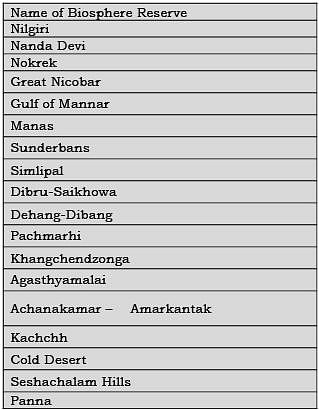Bio-Diversity-2 - UPSC MCQ
25 Questions MCQ Test - Bio-Diversity-2
The most important strategy for the conservation of biodiversity together with traditional human life is the establishment of
| 1 Crore+ students have signed up on EduRev. Have you? Download the App |
Out of all the Biosphere reserves in India, four have been recognised on the World Network by UNESCO.
Which one of the following is not one of them?
Which one of the following is not one of them?
Match List-I (Biosphere Reserves) with List-I (States) and select the correct answer using the codes given below the Lists:
List-I
A. Similipal
B. DehongDeband
C. Nokrek
D. Kanchenjunga
List-II
1. Sikkim
2. Uttaranchal
3. Arunachal Pradesh
4. Orissa
5. Meghalaya
Codes:
a. A-1; B-3; C-5; D-4
b. A-4; B-5; C-2; D-1
c. A-1; B-5; C-2; D-4
d. A-4; B-3; C-5; D-1
With reference to 'Eco-Sensitive Zones', which of the following statements is/are correct?
1) Eco-Sensitive Zones are the areas that are declared under the Wildlife (Protection) Act, 1972.
2) The purpose of the declaration of EcoSensitive Zones is to prohibit all kinds of human activities in those zones except agriculture.
Select the correct answer using the code given below
Consider the following pairs:
1) Dampa Tiger Reserve Mizoram
2) Gumti Wildlife Sanctuary Sikkim
3) Saramati Peak Nagaland
Which of the above pairs is/are correctly matched?
Consider the following pairs:
1) Nokrek Biosphere Reserve Garo Hills
2) Logtak (Loktak) Lake Barail Range
3) Namdapha National Park Dafla Hill
Which of the above pairs is/are correctly matched?
Consider the following statements:
1) The boundaries of a National Park are defined by legislation
2) A Biosphere Reserve is declared to conserve a few specific species of flora and fauna
3) In a Wildlife Sanctuary, limited biotic interference is permitted
Which of the statements given above is/are correct?
Match List I (National Park/Wildlife Sanctuary) with List II (Nearby Town) and select the correct answer using the code given below the lists:
List-I
A. Chandra Prabha
B. Kerera
C. Jaisamand
D. Nahargarh
List-II
1. Jaipur
2. Jhansi
3. Agra
4. Varanasi
5. Udaipur
Codes:
a. A-4; B-1; C-5; D-2
b. A-5; B-2; C-3; D-1
c. A-4; B-2; C-5; D-1
d. A-5; B-1; C-3; D-2
Match List-I (National Park/Sanctuary) with List-II (State) and select the correct answer using the codes given below the Lists:
List-I
A. Kanger Ghati National Park
B. Nagerhole National Park
C. Kugti Wildlife Sanctuary
D. Sultanpur Bird Sanctuary
List-II
1. Chhattisgarh
2. Haryana
3. Himachal Pradesh
4. Karnataka
Codes:
a. A-3; B-2; C-1; D-4
b. A-1; B-4; C-3; D-2
c. A-3; B-4; C-1; D-2
d. A-1; B-2; C-3; D-4
Match List-I (National Park/Wildlife Sanctuary) with List-II (State) and elect the correct answer using the code given below the lists:
List-I (National Park/Wildlife Sanctuary)
A. Bondla Wildlife Sanctuary
B. Kangerghat National Park
C. Orang Sanctuary
D. Ushakothi Wildlife Sanctuary
List-II (State)
1. Orissa
2. Assam
3. Chhattisgarh
4. Goa
5. Tripura
Codes:
a. A-2; B-1; C-5; D-3
b. A-4; B-3; C-2; D-1
c. A-2; B-3; C-5; D-1
d. A-4; B-1; C-2; D-3
Recently, there was a growing awareness in our country about the importance of Himalayan nettle (Girardiniadiversifolia) because it is found to be a sustainable source of
Government of India encourages the cultivation of 'sea buckthorn'. What is the importance of this plant?
1) It helps in controlling soil erosion and in preventing desertification.
2) It is a rich source of bio-diesel.
3) It has nutritional value and is well-adapted to live in cold areas of high altitudes.
4) Its timber is of great commercial value.
Which of the statements given above is/are correct?
Consider the following statements:
1) The Taxus tree naturally found in the Himalayas
2) The Taxus tree is listed in the Red Data Book
3) A drug called "Taxol" is obtained from Taxus tree is effective against Parkinson's disease
Which of the statements given above is/are correct?
With reference to 'Red Sanders', sometimes seen in the news, consider the following statements:
1) It is a tree species found in a part of South India.
2) It is one of the most important trees in the tropical rain forest areas of South India.
Which of the statements given above is/are correct?
Consider the following statements:
1) The common Blue green algae, Spirogyra and Ulothrix are found in both fresh water ponds and oceans.
2) The chameleon can look ahead with one eye, and at the same time look behind with another.
Which of these statements is/are correct?
Recently, our scientists have discovered a new and distinct species of banana plant which attains a height of about 11 metres and has orange-coloured fruit pulp. In which part of India has it been discovered?
In a particular region in India, the local people train the roots of living trees into robust bridges across the streams. As the time passes, these bridges become stronger. These unique 'living root bridges' are found in
Which one of the following groups of plants was domesticated in the ‘New World’ and introduced into the ‘Old World’?
In India, the use of carbofuran, methyl parathion, prorate and triazophos is viewed with apprehension. These Chemicals are used as
With reference to the circumstances in Indian agriculture, the concept of "Conservation Agriculture” assumes significance. Which of the following fall under the Conservation Agriculture?
1. Avoiding the monoculture practices
2. Adopting minimum tillage
3. Avoiding the cultivation of plantation crops
4. Using crop residues to cover soil surface
5. Adopting spatial and temporal crop sequencing/crop rotations
Select the correct answer using the code given below:
Consider the following agricultural practices:
1. Contour bunding
2. Relay cropping
3. Zero tillage
In the context of global climate change, which of the above helps/help in arbon sequestration/storage in the soil?



















